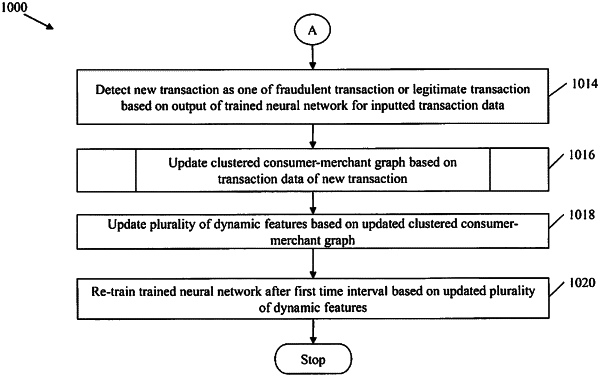| CPC G06Q 20/4016 (2013.01) [G06N 3/08 (2013.01)] | 20 Claims |

|
1. A method for detecting fraudulent transactions, the method comprising:
generating, by a server, a graph including a plurality of nodes and a plurality of edges between the plurality of nodes based on historical transaction data of a plurality of historical transactions, wherein each historical transaction of the plurality of historical transactions is executed between a consumer of a set of consumers and a merchant of a set of merchants, and wherein the plurality of nodes include a set of merchant nodes corresponding to the set of merchants and a set of consumer nodes corresponding to the set of consumers;
determining, by the server, a set of static features based on the historical transaction data and a plurality of dynamic features based on the generated graph;
training, by the server, a neural network based on the set of static features and the plurality of dynamic features, for detection of transaction fraud, wherein the trained neural network is used to detect a first transaction as one of a fraudulent transaction and a legitimate transaction based on first transaction data of the first transaction;
receiving, by the server, one or more real-time transactions data;
determining, by the server, that a change in the plurality of dynamic features caused by the one or more real-time transactions data is greater than or equal to a threshold level;
responsive to the determination that the change in the plurality of dynamic features is greater than or equal to the threshold level:
updating, by the server, the plurality of dynamic features based on the determination that the change is greater than or equal to the threshold level to limit use of computing resources for the updating only when the change is greater than or equal to the threshold level;
updating, by the server, the graph based on the updated plurality of dynamic features; and
retraining, by the server, the neural network based on the updated graph, wherein the neural network is retrained based on the one or more real-time transactions data only when the change in the plurality of dynamic features based on the one or more real-time transactions data is greater than or equal to a threshold level to limit use of computing resources for the retraining.
|